Click here to print
Ongoing Greatness and What Brings You to Maine?
posted November 5, 2015
By Melissa Dollman
n
Northeast Historic Film Wunderkino 5: Moving Images of War and Peace. 23-25 July 2015. Bucksport, Maine, USA.
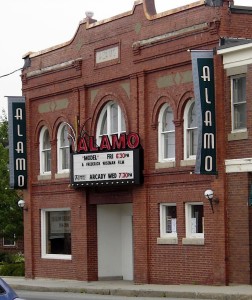
Alamo Theatre, 2006. Courtesy of Melissa Dollman
n
Northeast Historic Film’s yearly Summer Symposium, held 23-25 July 2015 in Bucksport, Maine, celebrated its fifteenth consecutive year as an intimate gathering of archivists, scholars, and artists devoted to the history, theory, and preservation of moving images. Oh, and the symposium takes place in a nearly 100-year-old venue called Alamo Theatre!
Much change can take place over the course of a decade and a half, but quality has been a constant with the Summer Symposium. This year’s organizers maintained what’s so appealing and rewarding about making the trek to rural Maine for a few days of watching archival films and video (beyond making the trek to rural Maine and watching archival films and video for a few days). Jennifer Jenkins (University of Arizona), Oliver Gaycken (University of Maryland), and Caitlin McGrath (University of Maryland and Greenbelt Theater) curated a thought-provoking program of research-based presentations that explored a weighty subject — war and peace — from diverse perspectives. And archival moving images were at the core of this program.
What might a newcomer expect of the Summer Symposium? For the past five years, symposium-goers have been treated to a glimpse of Northeast Historic Film’s own collections as presented by recipients of the William O’Farrell Fellowship, a research grant the archive funds. This summer, 2014 awardee Liz Czach (University of Alberta) revealed how amateur filmmaker Archie Stewart experimented with audio equipment throughout his lifetime of shooting both small-gauge film and video.
Return attendees would surely mention the Alamo’s and archive’s terrific staff; how the symposium schedule accommodates the admiration of the Bucksport Bay Festival parade — Shriners and all — going down Main Street past the theater’s windows; the lovely drive down/up Route 1 from either Bangor* or Boston airports to Bucksport; the special “off-campus” screenings which this year took the form of a Friday-night WWII Night at the Movies programmed by Liz Coffey and Sharon Thompson and introduced by Paul Spehr; scholars and presenters of every age; the “Big Chicken Barn” antique store over in Ellsworth; the supreme seafood options and locally-made ice cream a few doors down from the Alamo; swimming holes; and charming old New England generally.
What was unique for 2015? As is the case each year, Jenkins, Gaycken, and McGrath curated within the constraints of a new theme, and as a result, they attracted fresh faces with nascent theories around that theme. 2015 also heralded incoming Executive Director, Brook Minner, who replaced long-time NHF director and co-founder David Weiss. And it was the inaugural year of Archive Service Day, a pre-symposium experiment whereby volunteers repaired and organized old projectors, or reviewed and cataloged items in the moving-image collections. Lastly, a school bus brought attendees to a new outdoor location near the water for a closing-night lobster feast.
Rhetoric of War and Peace
Sometimes it’s difficult to remember what was significant about an event you attended some months earlier, what your visceral responses were, and what you imagined the take-away at the time was certain to be. Unsurprisingly this year’s theme “War and Peace,” when condensed into three days of visual impressions and thoughtful contextualization, produced a lasting impact. Most striking is the fact that the presenters skewered the fallacy that wartime and peacetime are polar opposites. In its place they offered confirmation — using moving images as their primary evidence — that minds and bodies required leisure time, or activities to keep their hands busy, during times of duress. Afterwards, incumbent fears and suspicions suppressed while at war seemed to linger throughout peacetime, forcing hyper-alertness and, sometimes, making enemies of strangers. Whether the newly identified enemies were old friends like disease, the Axis Powers, poverty, or Communists trying to infiltrate American society, rhetoric in this year’s selection of films varied from the purely visual to the soft sell to not-so-subtle propaganda.
Familiar, yet foreign, silent black-and-white and color home movies employing only the visual rhetoric of individual amateur filmmakers forced the audience into a silent reverence for the past, despite the verbal annotations offered by presenters. We watched films shot by a WWII Medical Unit surgeon throughout his down time in the Pacific Campaign (if it weren’t for personal objects like home movies, how little would we know about leisure during wartime?). This came to mind as I listened to Inside the General Hospital: Physician Films from WWII Medical Units, a presentation by Timothy Wisniewski from The Johns Hopkins University.
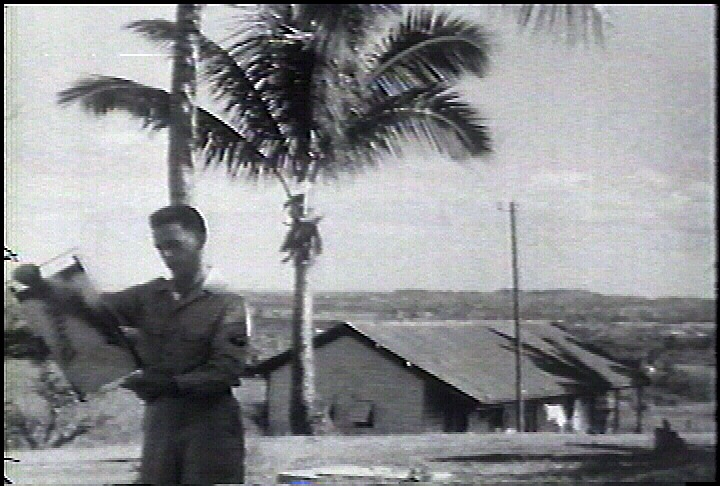
U.S. Army physician reading a chest x-ray. R. Carmichael Tilghman, Films of the 18th General Hospital (1942-1945), 16mm. Alan Mason Chesney Medical Archives, Johns Hopkins University.
n
Vermonters filmed their National Guard’s war-bond fundraising efforts and Rutland townspeople for the benefit of local boys fighting overseas, as we heard from Fred Pond (University of Vermont) in his paper, Vermont’s Home Front Response to War.
Military personnel bore witness, through their camera lenses, to the barbarisms discovered upon liberating Dachau, Nordhausen, Buchenwald, and Belsen concentrations camps, related Lindsay Zarwell of the US Holocaust Memorial Museum in Seeing was Believing: Recording Nazi Camps on Amateur Film.
We were treated to a variety of propagandistic fare.
In her Nursing the Home Front: The Henry Street Settlement Visiting Nurse Service’s Keep ‘Em Fighting, Tanya Goldman (New York University) discussed a 1942 fundraising snipe in which nurses made home visits for a New York City-based corps of The Henry Street Settlement nurses. (Snipes are, except for trailers, shorts, or cartoons, the material shown in movie theaters before the main feature.)
Unseen Casualties: VD Films in War and Peace, presented by Heidi Holmstrom and Audrey Amidon of the National Archives and Records Administration, examined government-funded sex hygiene films presenting the problem of indiscriminate venereal diseases separately to African-American soldiers from their white counterparts.
In his presentation, P is for Patriot: The Manufacturing of Americans from WWII-Vietnam, Devin Orgeron of North Carolina State University analyzed social-engineering films (WWII to the Vietnam) that employed era-specific rhetoric in their approach to educating Americans on good citizenship.
Another presentation provided a fascinating look at how British Instructional Films kept stiff upper lips as their historical recreations of Britain’s sea battles finally dealt with the crown’s first real loss in the 20th Century.
In the category of the softer sell, we were exposed to a more deceptive kind of manipulation, the indirect message, and communication through omission or analogy.
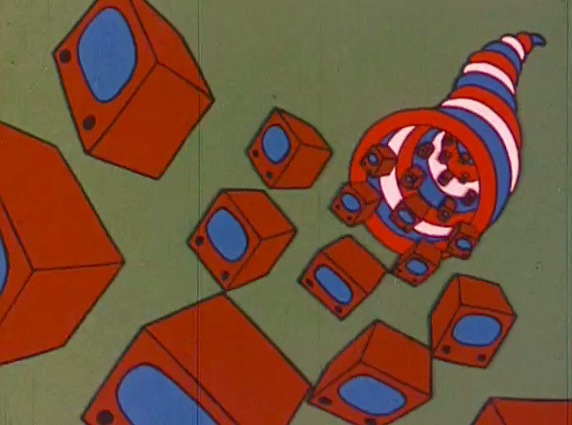
200 (1976) Vince Collins, Animator Bicentennial Grant Project sponsored by the United States Information Agency.
n
Films produced by U.S. Department of Agriculture and the American Committee for a Devastated France informed WWI-era American and French working-class housewives about the merits of canning and eating cottage cheese (and upward mobility), as Christine Gorby of the University of Pennsylvania showed in Preserved Food, Identity and Experience in Post-WWI: American Home Canning in France (1919).
In Lost WWII Women Directors, Screenwriters & Editors, Sharon Thompson of the Lesbian Home Movie Project discussed screenwriters and directors like Marion Dix and Elizabeth Wheeler who were forgotten in the annals of film production history.
Bell & Howell and Kodak marketed handheld film cameras to returning WWII veterans by employing subtle symbolism they could relate to: battle, shooting, and Westerns; Stephen Monteiro, American University of Paris, discussed this in his presentation, Shoot the Kids: Violence and Postwar Home Media.
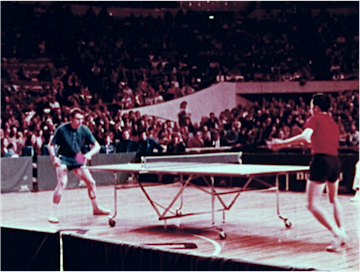
Chinese Table Tennis Delegation in USA (The Central Newsreel and Documentary Films Studio of The People’s Republic of China, 1972) Courtesy of the Chinese Film Collection at Moving Image Resource Center, University of South Carolina.
The United State Information Agency, explained Brian Real of the University of Maryland, College Park, in his A Time To Play: Frivolous Cinema as Cold War Weaponry, chose a multi-screen film featuring frolicking children entitled A Time to Play in its effort to outshine the Soviets during Montreal’s Expo ’67.
Lastly, perhaps my favorite film of the symposium, discussed by the University of South Carolina’s Travis Wagner in his “Winning or Losing is Temporary, Friendship is Eternal”: The Conflation of Cultural Diplomacy and Warfare in Chinese Ping-Pong in U.S.A., was Chinese Table Tennis Delegation in USA. It embodied the idea of “Ping-Pong diplomacy,” and how athletes often make wonderful ambassadors, while their respective governments spin yarns of cultural superiority. I loved it.
* One last thing…If you take a cab from Bangor Airport, prepare to chat with your driver (the unofficial tour guides in every city) about Stephen King at some point during that 30-minute drive.
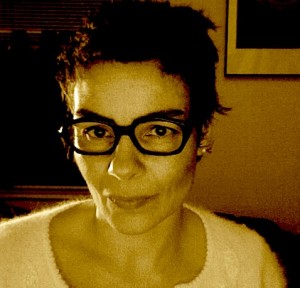 Melissa Dollman is a moving-image archivist and researcher based in North Carolina.
Melissa Dollman is a moving-image archivist and researcher based in North Carolina.
Printed from Moving Image Archive News: http://www.movingimagearchivenews.org
URL to article: http://www.movingimagearchivenews.org/ongoing-greatness-and-what-brings-you-to-maine/
Click here to print